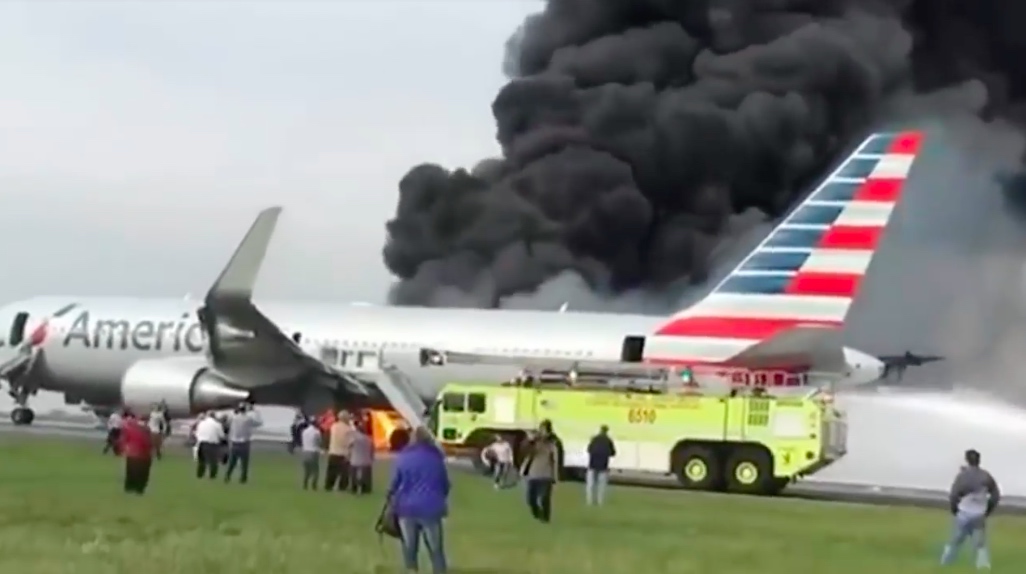
American Airlines has responded to a list of safety recommendations made by the National Transport Safety Board to better it’s flight attendant training.. On October 28th, 2016 American flight 383 was taking off from Chicago O’Hare International for it’s 2 and a half hour flight to Miami when the right engine failed.
The uncontained failure resulted in a large engine fire but fortunately for everyone onboard, the flight crew successfully aborted the take-off before it was too late. All 161 passengers and 9 crew members were quickly evacuated – thanks in large part, the NTSB says, to the skill and quick thinking of flight attendants onboard the aircraft.
But not all went smoothly in the evacuation of American 383. The NTSB noted there were “numerous problems” with the evacuation – including a lack of communication between flight attendants and the flight crew.
Investigators also said flight attendants deviated from standard operating procedures and failed to coordinate properly once everyone was off the burning plane. The board concluded that a passenger was seriously injured from jet blast after a flight attendant sent them down an emergency chute before the left engine had been turned off.
Making a series of recommendations, the NTSB said both the FAA and American should improve its flight attendant training programmes – specifically in relation to evacuation techniques, communication and use of interphone’s. As an alarming side note, several flight attendants on the doomed plane forgot how to use the interphone system.
In a recent article, we suggested American would do well to learn from the event and take-up the NTSB’s recommendations. While in this case the accident was proven to be caused by a mechanical defect, the vast majority of aviation disasters are as a result of so-called “human factors”.
Providing both pilots and flight attendants adequate training to identify and mitigate these factors can go a long way to improve safety.
When we reached out to American to hear their thoughts on this – and find out whether they would be improving safety training, they said they had already done so. Taking the recommendations of the NTSB fully onboard.
In a written submission, the airline had they had “enhanced its crew training to increase awareness of specific issues amidst an emergency evacuation.”
The airline had also made significant updates to training in the use of interphones.
Jill Surdek, American’s vice president for flight services, told us that the airline “wanted to thank the NTSB on its work,” and went on to explain:
“We are incredibly proud of how our flight attendants performed a successful evacuation of the aircraft. They promptly initiated and supervised a very effective emergency evacuation.”
Going into details about the events onboard flight 383, Surdek told us:
“Each flight attendant ensured the safe evacuation of passengers at the respective exit doors and then ensured no passengers remained on the aircraft before exiting. As part of their training, the flight attendants blocked certain emergency exits and redirected passengers away from exit routes that were unsafe due to the fire.”
“Their judgement, skill and self-discipline likely prevented significant injuries. Their performance as a team contributed to a safe outcome for our customers and crew.”
“American is proud of the skills and professionalism of our crew members.”
Surdek then attacked the actions of some passengers who stopped to take carry-on luggage with them during the evacuation:
“We remain concerned about passengers who attempted to evacuate the aircraft with carry-on luggage and other non-essential personal belongings. American believes this is an issue that warrants additional industry attention given the risk that this poses by slowing the evacuation and potential puncturing and deflating critical escape slides.”
Clearly, this is a huge issue. Every emergency evacuation we’ve witnessed in the large few years has seen passengers selfishly stopping to take their personal belongings with them.
Whether this is because those passengers who find themselves in an emergency situation aren’t aware of the danger, are in a state of panic or just don’t care, Surdek’s call for more action will certainly resonate with both airline staff and frequent flyers.
Surdek was backed up by American’s vice president for flight, Kimball Stone who spoke about American’s training programmes:
“American has a robust safety culture, sound training programmes for pilots and flight attendants and a well-proven operational and maintenance procedures. these aspects played a significant role in ensuring the challenges faced by our passengers and crew on flight 383 were managed to a safe resolution.”
Related
Mateusz Maszczynski honed his skills as an international flight attendant at the most prominent airline in the Middle East and has been flying ever since... most recently for a well known European airline. Matt is passionate about the aviation industry and has become an expert in passenger experience and human-centric stories. Always keeping an ear close to the ground, Matt's industry insights, analysis and news coverage is frequently relied upon by some of the biggest names in journalism.







